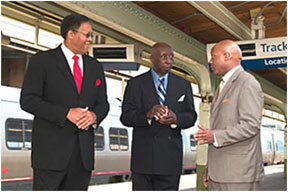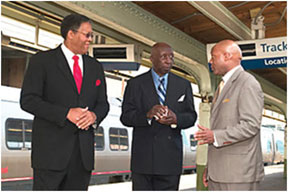

Trains, Parks, Pullman Porters & A Unique Travel Guide
Former porters (from left) Bill Costen, Thomas Dunn, and E. Donald Hughes II were honored by Amtrak in a ceremony at Washington’s Union Station, 2008 (CSM Photo)
By Audrey Peteramn
Welcome to Day #117 of our “365 Parks in 365 Days” adventure! We’re coming up fast on Memorial Day – the un-official start of the Great Travel & Get Outdoors Season. While there is an abundance of travel guides to our National Park System, Our True Nature is the only one written from the perspective of an African American traveler and advocate for the parks. It’s as unique and useful to the seasoned park traveler as it is to those who’re considering visiting the parks for the first time.
As an author, my chief indicator of success is the number of books sold, so if you haven’t got your copy yet, please get it today. Incidentally, close friends mention that I’m “giving too much away” with these posts so people may not feel the need to purchase the book. I hope that’s not the case, and I am making a personal appeal to everyone who enjoys these stories to honor my efforts and buy the book so I can continue to supply this wonderful information.
On Day #117, we’re heading to a unit of the park system that I didn’t even know exists until I got a note from my friend who’s Chief of Interpretation at Steamtown National Historic Site in Pennsylvania:
“Hey Audrey, you may remember me from Yosemite- I briefly had the pleasure of being Shelton (Johnson’s) supervisor. I am at Steamtown now, and we were speaking of reaching out to diverse groups about the Pullman Porter story … At the time it was a job that got African American men a good salary and travel even if today we are appalled at the audacity of the segregation of jobs on railroads. America was spread by railroads in the late 1800’s and early 1900’s. Would you care to cover Steamtown at some point? I’d be happy to do whatever research you need.”
Yes, yes and yes, Mary! Thank you! I love how this “365” series builds upon itself and enables so many connections.
Here are a few of the comments I’ve received since last week that particularly touched me:
“Audrey, I just read your ac-count of viewing Old Faithful at daybreak- it brought tears to my eyes! I work for the Yellow-stone Park Foundation, the official fundraising partner of Yellowstone National Park, and have been visiting the Park since I was a child. Often, after one has seen something time and time again, the magnitude can be lost. Thank you for re-minding me of the wonder of Old Faithful and Yellowstone! Regretfully, the Today Show did not tape in Yellowstone due to the events in Oklahoma. We hope they will reschedule so that the splendor of YNP can be shared! ”
“Thanks for introducing us to these dedicated nature lovers. (Changing of the Guard) One day may the seemingly quiet human souls among us suddenly stand out, and together, lead us back and forward to sanity and save planet Earth.”
That is my vision and goal as well, and the driving force behind all my efforts.
According to Mary, Steamtown National Historic Site was set aside to provide sufficient year-round facilities and programs so that visitors can understand the role of steam and diesel railroads in the growth of our country, while allowing opportunities for hands-on, active experiences, including riding on a train and how they operate. You can take a ride in a historic commuter car pulled behind a vintage steam locomotive around the railroad yard or even on extended trips around the Pennsylvania area. Walk through the Technology Museum for the nuts and bolts explanation of the evolution of the steam locomotive, and visit the History Museum for the human history of the American railroad. Living history programs are offered that allow you to put yourself in the shoes of a depression-era hobo, a 1920’s yard worker, and other historic characters of the rail yard and locomotive industry.
Researching the history of Steamtown led me to the indispensable role that trains played in popularizing the national parks, as the primary means of long distance travel in the 19th and early 20th centuries. The trains took financially well-off Americans to see the wondrous West, and helped develop the public support to protect more land as part of the park system. Black Pulman porters were an indispensable part of this experience, providing the “luxury” that travelers enjoyed.
I also discovered how multi-layered this story is, and the central role that Chicago played in its evolution. Coincidentally, I’m heading to Chicago to Keynote the Cook County Forest Preserve’s Centennial Celebration June 12 at the Chicago Cultural Center (I hear the Governor’s going to be there!) and, I just found that my very own NPCA has a proposal on the table to protect the Pullman District in Chicago as part of the park system, ensuring that its historic structures and museums remain intact! On top of that, Chicago is home to the A. Philip Randolph Pulman Porter Museum, which tells the story of the groundbreaking efforts African Americans made to organize as a labor movement. As you can imagine, I can hardly wait to get there and experience these places and bring you back first hand information.
According to NPCA, “Pullman is already recognized for its historical significance including the critical role of railroads in America’s industrial past, the formation of the first African-American labor union, and development of the country’s first model industrial town. The convergence of these uniquely American stories of undisputed national significance makes Pullman worthy of national park status.”
I found this story in the Christian Science Monitor:
“The little-known history of the Pullman porters, who for more than a century provided the top-notch service demanded by Pullman Palace Cars and their mostly well-to-do white passengers, reveals in many ways the first emergence of a lack middle class in the United States and the first foundation for a generation of Black leaders in the 20th century. Thurgood Marshall and his father both worked as Pullman porters, as did Malcolm X and the distinguished photo journalist Gordon Parks.
“Being a train porter was one of the first relatively well-paying jobs for former slaves after the Civil War, and by the mid-1920s, peak years for passenger trains, more than 20,000 African-American men were employed as Pullman porters and other types of train personnel, the largest category of Black labor in the United States and Canada at the time.
“ ‘We had it relatively easy compared to the gentlemen who came at the tail end of the Emancipation Proclamation,’ says E. Donald Hughes, another former Pullman porter. “The sleeping car porter had to endure all manner of horrendous treatment…. And yet, in the black community, they were the highest you could be. When they put on that uniform, they were larger than life. And yet, in the white community, they were still the lowest of the low.”
“Indeed, when George Pullman first developed the ‘Pullman sleeper’ or ‘Pullman Palace Car,’ he marketed it as ‘luxury for the middle class.’ In the decades after the Civil War, he went south to recruit the best and brightest former slaves to work on these rolling five-star hotels, men who had already been trained to perform the service duties he required.
My friend Mary shared this from her research.
“Jewell Brown, a former Pullman porter and Brotherhood of Sleeping Car Porters representative summarized the experience: ‘This is what made those great trains and railroads great—the type of service that was rendered by these employees. The train itself was just a cold piece of steel.’
“One railroad author wrote that ‘The railroad passenger car workers transformed these” cold pieces of steel” into a warm, inviting atmosphere and did more than simply provide a service: in their hands, passenger cars were a kind of theater, orchestrated by the railroads and sold to a willing audience.’ (Those Pullman Blues by David Perata.)
“From the same book I found this quote from a porter named James Steele ‘You meet a lotta big people, I had Bing crosby …. in my car, 25$ everytime I caught him! Well I tell you what happened one night. Big Crosby was on and that’s when I was on the front car first, see. Being Crosby came back, lay down on the floor, and sang the most beautiful songs that you ever heard. And we would sell more whiskey and champagne than we could bring out, see. When Bing Crosby was with his wife, He’d always have the drawing room, I would keep all his bags out but his golf clubs and an overnight bag. I’d bring that in at night, that evening when he got on. And then I’d go get some glasses and a big bowl of ice. He always carried his whiskey in his golf bag…’ “
So now I’m raring to visit Steamtown and the Pullman District in Chicago and the A. Philip Randolph Museum, and generally to follow the history of the railroad wherever they may lead me across this grand and beautiful country of ours. I am so grateful for the National Park System that protects and preserves these seminal stories for us to enjoy and learn from!
Get Our True Nature. I’m working to correct the price below from $21.95 to the accurate price of $18.95 each, with an additional $3.00 for shipping and handling. Click on this link with the correct price, www.legacyontheland.com and I will send an autographed copy with a personal message to you!)
Publication of “Our True Nature: Finding A Zest for Life in the National Park System” is supported by Delaware North Companies, Inc., Forever Resorts and Guest Services.



Be the first to comment